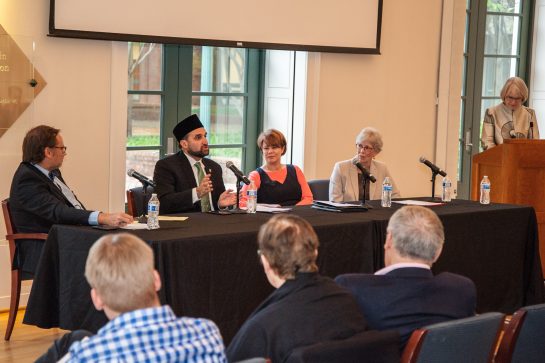Who are these 8 year-old and 15-year-old girls who are the future leaders in the Church? What is their training like in your ward and stake?
In the first talk of this fall’s general conference, Sister Sharon Eubank looked at them and said “I am going to pass this torch to you. You are the future leaders in this Church, and it will be up to you to carry this light forward and be the fulfillment of this prophecy.” She referred to President Kimball’s statement:
“Much of the major growth that is coming to the Church in the last days will come because many of the good women of the world … will be drawn to the Church in large numbers. This will happen to the degree that the women of the Church reflect righteousness and articulateness in their lives and to the degree that the women of the Church are seen as distinct and different—in happy ways—from the women of the world.”
Two days before her talk, I met Sister Eubank as she took part in a panel hosted by UVA’s Mormon Studies program. The panel, on refugee relief, included Anwar Khan, the CEO of Islamic Relief. During his comments, Mr. Khan described coming to the United States to continue his relief and development work. He said at first it was hard to find people who believed in his cause and who would rally behind him. But the first strong supporters were sixteen-year old girls. “And then their mothers joined them, and then their brothers, and finally their fathers.” I was so struck by this progression, by the will and leadership exhibited by teenage girls who became not only humanitarians but community movers.

Are our young women our greatest untapped resource? Young men are granted a natural and permanent stewardship via their priesthood duties and callings, but no parallel stewardship is extended to the young women. Although in my YW days I had many opportunities to serve in our ward and community, my church leadership and service development lacked the continuity and permanence (and maybe also some of the purpose) that my male counterparts experienced.
This means that young women must seek out a stewardship themselves, and that local leaders must creatively encourage young women to develop the leadership and “articulateness” that will enable them to carry Sister Eubank’s torch. What is the stewardship of the young women in your ward? What are their regular responsibilities?
One ward YW president with whom I spoke recently said that her young women have “adopted” the widows of the ward. They regularly visit and care for these women, developing ongoing relationships with them. Imagine the lessons in ministry and leadership these young women are learning via this permanent stewardship, in comparison to a once-a-year service project or cookie delivery.
Another ward leader recently submitted an example of young women who rotate with the young men in helping residents of an assisted living center walk next door to church. Are there regular responsibilities your ward’s young men are covering, for which your young women might take joint-ownership?
Mr. Khan’s remarks make me feel that all we really need to do to develop young women leaders in the church is not to douse their natural spark. I recently met a woman whose husband unexpectedly passed away this year, leaving behind herself and four young children. A 14-year-old girl in her ward who had not known her well previously offered to come over and help her with the kids. She came again and again, and still comes, and they have developed a rich familial relationship. This grieving sister could hardly share the story for her tears of gratitude toward this young woman, who driven by charity and wisdom seemingly beyond her years chose for herself a challenging and lasting stewardship. Do we underestimate our young women?
This wisdom and vision are the birthright of every LDS girl and woman. But if their wards and stakes do not offer them an outlet for their ministry, they are likely to find it elsewhere. There is nothing wrong with this, and indeed Sister Eubank encourages us to take our light out into the world. But if when young LDS women turn back from the world on Sunday to go to church they find no similar opportunity to lead and minister, will they feel needed there? Will they stay? And if on the other hand, they believe the Church programs have set the bar and there is no need to stretch themselves beyond it, will they reach their potential? Will they realize the God-given stewardship that is native to their hearts? These are questions whose answers may vary in every stake across the world.
Tell me how your wards and stakes are empowering and preparing your young women for the ministry Sister Eubank outlined.
NOTE: In two of the above examples, bridges of leadership, stewardship, and ministry are built between Young Women and Relief Society women. These connections are particularly powerful in that they represent the connection between “quorums” of varying ages and responsibilities, paralleling the priesthood organization. How much more purpose and vision will our young women perceive in the torch they are being handed, if they understand their organization to lead naturally into the Relief Society, with its clearly designated mission and its powerful origins? In our next blog post, a Boston Relief Society president will write particularly about developing local female leadership through inter-auxiliary cooperation.
